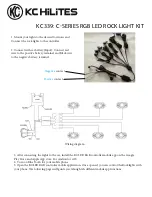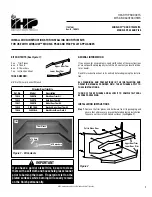
• Symptoms [OBD II DTC’s: P0110 ~ P0114]
Poor fuel economy, hard start, high emissions, tip-in hesitation
• Test Procedure
1. Backprobe the terminals on the IAT sensor with the CH A lead and its ground lead.
2. When the IAT sensors are at engine operat ing temperature, spray the sensors with a cooling spray, a wat er
spray, or evaporative solvent spray and monitor the sensor voltage. Perform this test with the Key ON, Engine
Off. The waveform should increase in amplitude as the sensor tip cools.
3. Press the HOLD key to freeze the waveform on the display for closer inspection.
4. To measure resistance, disconnect the sensor before changing to the GMM mode and then connect the Ground
and CH A leads to the terminals on the sensor.
• Reference Waveform
VEHICLE INFORMATION
YEAR
: 1986
MAKE
: Oldsmobile
MODEL
: Toronado
ENGINE
: 3.8 L
FUELSYS : Multiport Fuel Injection
PCM_PIN : C11 Tan wire
STATUS
: KOEO (Key On Engine Off)
RPM
: 0
ENG_TMP : Ambient Temp.
VACUUM : 0 In. Hg
MILEAGE : 123686
• Troubleshooting Tips
Check the manufacturer’s specifications for exact voltage range specifications, but generally the sensor’s voltage
should range from 3 V to just under 5 V when stone cold, dropping to around 1 to 2 V at operating temperature. The
good sensor must generate a signal with a certain amplitude at any given temperature.
Opens in the IAT sensor circuit will appear as upward spikes to V Ref.
Shorts in the IAT sensor circuit will appear as downward spikes to ground level.
Knock Sensor
• Theory of Operation
AC signal generating Knock Sensors are piezoelectric devices that sense vibration or mechanical st ress (knock)
from engine det onation. They are quite different from most other A C signal generating aut omotive sensors t hat
sense the speed or position of a rotating shaft.
Engine detonation resulting from overadvanced ignit ion timing can cause severe engine damage. Knock sensors
supply the PCM (sometimes via a spark control module) with Knock detection so the PCM can retard ignition timing
to prevent further Knocking.
6-9
Intake Air Temp sensor sprayed
with brake cleaner here. As
sensor tip cools, voltage
increases.
Key On Engine Off
“Spray” test Intake
Air Temp. Sensor
MAX = 3.26
MIN = 1.86
Key On
Engine Off
here
• Test Procedure
1. Backprobe the terminals on the FT sensor with the CH A lead and its ground lead.
2. Start the engine and hold the throttle at 2500 RPM until the trace goes across the screen.
3. Set t he time base to 50 sec/ div t o see t he sensor’s entire operat ing range, from stone cold to operating
temperature.
4. Press the HOLD key to freeze the waveform on the display for closer inspection.
5. To measure resistance, disconnect the sensor before changing to the GMM mode and then connect the Ground
and CH A leads to the terminals on the sensor.
• Reference Waveform
VEHICLE INFORMATION
YEAR
: 1988
MAKE
: Nissan/Datsun
MODEL
: 300 ZX non-turbo
ENGINE
: 3.0 L
FUELSYS : Multiport Fuel Injection
PCM_PIN : 15 Yel wire
STATUS
: KOER (Key On Running)
RPM
: 2000
ENG_TMP : Warming Up
VACUUM : 21 In. Hg
MILEAGE : 57782
• Troubleshooting Tips
Check the manufacturer’s specifications for exact voltage range specifications, but generally the sensor’s voltage
should range from 3 V to just under 5 V when stone cold, dropping to around 1 to 2 V at operating temperature. The
good sensor must generate a signal with a certain amplitude at any given temperature.
Opens in the FT sensor circuit will appear as upward spikes to V Ref.
Shorts to ground in the FT sensor circuit will appear as downward spikes to ground level.
INTAKE AIR TEMP (IAT) Sensor
• Theory of Operation
Most Intake Air Temperature (IAT) sensors are Negative Temperature Coefficient (NTC) type thermistors. They are
primarily two wire analog sensors whose resistance decreases when their temperature increases. They are supplied
with a 5 V V Ref power signal and return a voltage signal proportional to the intake air temperature to the PCM.
Some sensors use their own case as a ground, so they have only one wire, the signal wire. When this instrument is
connected to the signal from an IAT sensor, what is being read is the voltage drop across the sensor’s NTC resistor.
Typically, IAT sensor’s resistance ranges from about 100,000 ohms at -40 ˚F (-40 ˚C) to about 50 ohms at +266 ˚F
(+130 ˚C).
6-8
Engine warmed
up for 8 minutes
here
MAX = 3.13 V
MIN = 2.66 V
Engine stone
cold here
















































